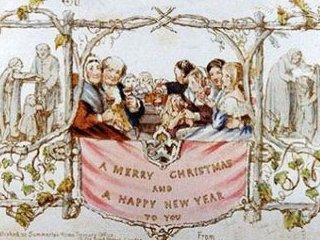
© Photo: archive
Christmas wishes from last century come to life in the latest exhibition at the Sofia City Library. It is called “The great-grandmother to the MMS…or the charm of the Christmas card.” The exposition is devoted to the anniversary of the first Christmas greeting card. There, visitors can see a copy of the first Christmas card sent in 1843. The idea came to British businessman and founding director of the Victoria and Albert Museum Henry Cole. At that time people would exchange Christmas greetings with the help of lithographs, especially decorated and engraved for the purpose. But Sir Henry Cole decided to make things easier and asked artist John Horsley to make 40 identical lithographs which he could send to friends and family. On these cards the artist painted Sir Henry’s family against the background of biblical stories as well as traditional Christmas decorations.

© Photo: Sofia Library
“The nobility thought they should advertise their gestures of charity, especially at Christmas time,” says Yovka Ivancheva from the Sofia City Library, a fourth-generation collector. “That is why the first card commissioned by Sir Henry Cole had a picture of his family around the Christmas table. On one side they are giving clothes to the poor and on the other – food. The symbolism of this first card is that one should show compassion.”

© Photo: Sofia Library
The exhibition includes unique Christmas cards from the turn of the 20th century from Yovka Ivancheva’s private collection. Some of them feature photographs of children around the Christmas tree or whole families. “They thought the family was the greatest of fortunes,” she says. However there is one card from 1915 that conveys a different message, valid to this day:
“We now wish each other prosperity, happiness, abundance,” Yovka Ivancheva goes on to say. “The idea behind this card is the same. It shows a baby on a chamber pot that is full of gold pieces. Back then cards were arranged in a special place in the home, on the mantelpiece or on a book shelf so that when guests came they would see them as evidence of the family’s’ standing in society.”

© Photo: www.libsofia.bg
And one more thing:
“Bulgarian institutions are always very careful in their choice of the greeting cards they send,” says Yovka Ivancheva. “They are usually copies of works by prominent Bulgarian artists or pieces from the Thracian treasures discovered in the Bulgarian lands. This tradition is alive to this day. The different subject matter on stamps and Christmas cards is indicative of how one imagines Christmas. There are some that are romantic: houses with a snow cap, tracks in the snow, illuminated windows. Many are connected with traditional scenes from Bulgarian folklore; there are some with Father Christmas or his reindeer or landscapes. Nowadays it is easy to find anything your heart may wish.”
English version: Milena Daynova
Leading researchers and lecturers from the St. Kliment Ohridski University in Sofia and the Institute of Astronomy and National Astronomical Observatory of the Bulgarian Academy of Sciences will be paying a visit to the Museum of Natural History in..
The village of Oryahovitsa, Stara Zagora region, today celebrates its symbol - the walnut tree. There will be a Festival of the Walnut with a varied programme featuring the Kazanlahsko Nastroenie (Kazanlak Cheer) Orchestra, the soloist of..
Disputes in Croatia over sending military personnel to NATO mission in support of Ukraine NATO Acting Deputy Secretary General Boris Ruge visited Croatia to explain to local MPs about the Alliance's mission in support..
The traditional Bulgarian Christmas picnic, organized by the Bulgarian Cultural and Social Association "Rodina - Sydney" and the Bulgarian School..
Two graduates of the Bulgarian School "Saints Cyril and Methodius" in Jordan presented their achievements at an event at their school "Hadi al Muhammadi"..
Radmila Sekerinska from North Macedonia appointed NATO Deputy Secretary General NATO Secretary General Mark Rutte has appointed Radmila Sekerinska..

+359 2 9336 661
